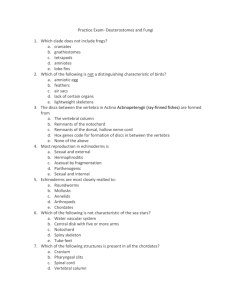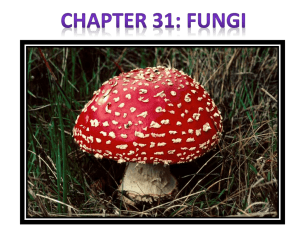Exam 1
advertisement
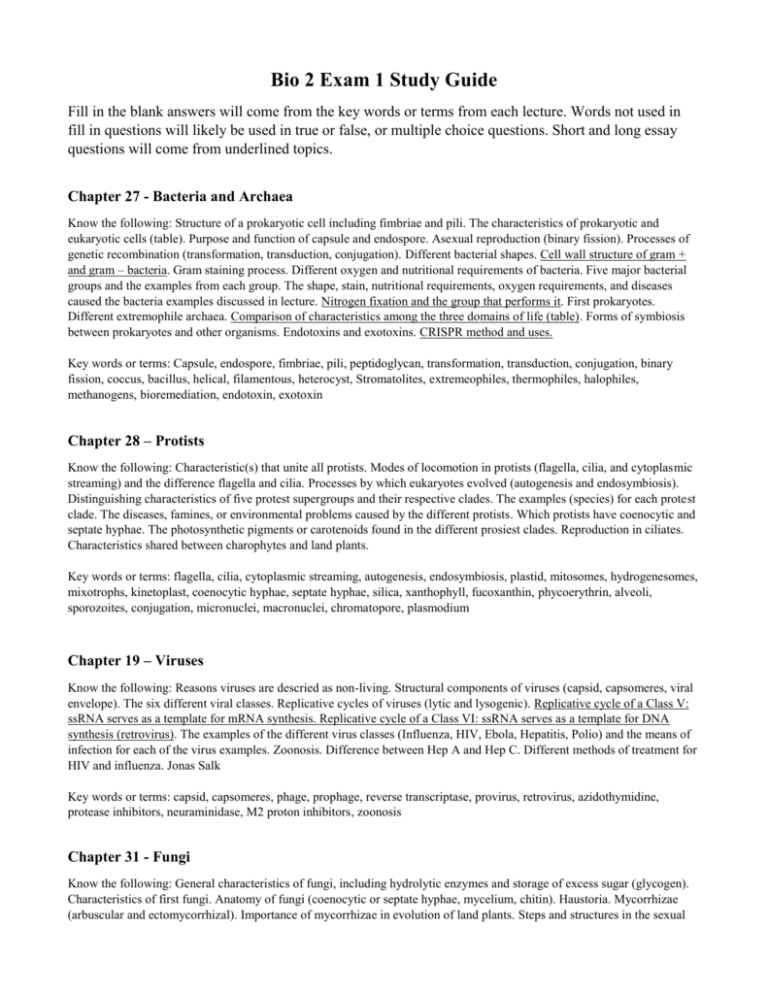
Bio 2 Exam 1 Study Guide Fill in the blank answers will come from the key words or terms from each lecture. Words not used in fill in questions will likely be used in true or false, or multiple choice questions. Short and long essay questions will come from underlined topics. Chapter 27 - Bacteria and Archaea Know the following: Structure of a prokaryotic cell including fimbriae and pili. The characteristics of prokaryotic and eukaryotic cells (table). Purpose and function of capsule and endospore. Asexual reproduction (binary fission). Processes of genetic recombination (transformation, transduction, conjugation). Different bacterial shapes. Cell wall structure of gram + and gram – bacteria. Gram staining process. Different oxygen and nutritional requirements of bacteria. Five major bacterial groups and the examples from each group. The shape, stain, nutritional requirements, oxygen requirements, and diseases caused the bacteria examples discussed in lecture. Nitrogen fixation and the group that performs it. First prokaryotes. Different extremophile archaea. Comparison of characteristics among the three domains of life (table). Forms of symbiosis between prokaryotes and other organisms. Endotoxins and exotoxins. CRISPR method and uses. Key words or terms: Capsule, endospore, fimbriae, pili, peptidoglycan, transformation, transduction, conjugation, binary fission, coccus, bacillus, helical, filamentous, heterocyst, Stromatolites, extremeophiles, thermophiles, halophiles, methanogens, bioremediation, endotoxin, exotoxin Chapter 28 – Protists Know the following: Characteristic(s) that unite all protists. Modes of locomotion in protists (flagella, cilia, and cytoplasmic streaming) and the difference flagella and cilia. Processes by which eukaryotes evolved (autogenesis and endosymbiosis). Distinguishing characteristics of five protest supergroups and their respective clades. The examples (species) for each protest clade. The diseases, famines, or environmental problems caused by the different protists. Which protists have coenocytic and septate hyphae. The photosynthetic pigments or carotenoids found in the different prosiest clades. Reproduction in ciliates. Characteristics shared between charophytes and land plants. Key words or terms: flagella, cilia, cytoplasmic streaming, autogenesis, endosymbiosis, plastid, mitosomes, hydrogenesomes, mixotrophs, kinetoplast, coenocytic hyphae, septate hyphae, silica, xanthophyll, fucoxanthin, phycoerythrin, alveoli, sporozoites, conjugation, micronuclei, macronuclei, chromatopore, plasmodium Chapter 19 – Viruses Know the following: Reasons viruses are descried as non-living. Structural components of viruses (capsid, capsomeres, viral envelope). The six different viral classes. Replicative cycles of viruses (lytic and lysogenic). Replicative cycle of a Class V: ssRNA serves as a template for mRNA synthesis. Replicative cycle of a Class VI: ssRNA serves as a template for DNA synthesis (retrovirus). The examples of the different virus classes (Influenza, HIV, Ebola, Hepatitis, Polio) and the means of infection for each of the virus examples. Zoonosis. Difference between Hep A and Hep C. Different methods of treatment for HIV and influenza. Jonas Salk Key words or terms: capsid, capsomeres, phage, prophage, reverse transcriptase, provirus, retrovirus, azidothymidine, protease inhibitors, neuraminidase, M2 proton inhibitors, zoonosis Chapter 31 - Fungi Know the following: General characteristics of fungi, including hydrolytic enzymes and storage of excess sugar (glycogen). Characteristics of first fungi. Anatomy of fungi (coenocytic or septate hyphae, mycelium, chitin). Haustoria. Mycorrhizae (arbuscular and ectomycorrhizal). Importance of mycorrhizae in evolution of land plants. Steps and structures in the sexual reproduction of fungi and asexual structures of fungi. Reproductive cycles of Zygomycete, Ascomycete and Basidiomycete fungi. Characteristics of the five major fungi classes. What makes fungi imperfect? Groups (protists, bacteria, fungi) that form the symbiotic relationship in lichens and what each group provides in the relationship. Mycosis. Key words or terms: Hydroltic enzymes, glycogen, coenocytic hyphae, septate hyphae, mycelium, chitin, haustoria. mycorrhizae, arbuscular, ectomycorrhizal, plasogamy, heterokaryon, karyogamy, zoospores, saprobes, zygosporangium, sporangia, conidia, conidiophore, asci, ascocarps, basidia, basidiocarps, soridia, mycosis Chapters 24, 25 and 26 – Evolution and Phylogeny Know the following: Contributions of Linnaeus, Lamarck, Cuvier, Lyell, and Wallace to the development of evolutionary thought. Who was the father of what science? Catastrophism. Uniformitarianism. Main themes of “The Origin of Species”. Role of mockingbirds and finches in development of Darwin’s theory. Difference between Lamarck’s and Darwin’s view on evolution using giraffes as an example. Darwin’s four postulates of natural selection. Microevolution, macroevolution, and speciation. Different forms of evidence for evolution. Difference between homologous and analogous structures. Convergent evolution. Radiometric dating. John Edler’s experiment on natural selection with guppies. Biological species concept. Different modes of speciation (allopatric and sympatric) and the processes involved in each mode (barriers, polyploidy, autopolyploidy, allopolyploidy). Three possible outcomes of hybrid zones. Adaptive radiation. How new traits arise (novelties, exaptation, changes in development). Function and importance of homeobox and hox genes and their role in evolutionary change. Gene expression. Allometric growth. Heterochrony. Paedeogenesis. Differences between anagenesis and cladogenesis. Differences between gradualism and punctured equilibrium. Are evolutionary trends goal oriented? Taxonomy. Ways of hypothesizing evolutionary relationships (synapomorpies, molecular data). Different processes used to determine DNA similarities between species (DNA-DNA hybridization, restriction maps, DNA sequencing). Why do we use mtDNA or rRNA? Molecular homoplasies. Molecular clocks. Know how to interpret phylogenetic trees (sister taxa, last common ancestor, monopyletic, paraphyletic, polyphyletic groupings). Different types of evolutionary trees (chronogram, phylogram, cladogram). Ways phylogenies are constructed (maximum parsimony, maximum likelihood, cladistics). Know how to construct a cladogram using a character table. Key words or terms: Catastrophism, uniformitarianism, microevolution, macroevolution, speciation, homologious structures, analogous structures, convergent evolution, vestigial traits, embryology, allopatric speciation, sympatric speciation, ecological niche, polyploidy, autoployploidy, allopolyploidy, adaptive radiation, exaptation, heterochrony, paedeogenesis, anagenesis, cladogenesis, gradualism, punctured equilibrium, molecular homoplasies, symplesiomorphy, synapomorphy, chronogram, phylogram, cladogram, phylogeny, monophyletic, paraphyletic, polyphyletic Cladogram practice problem. Construct the most parsimonious cladogram using the character table below. Taxa Assassin Beetle Bug 1 1 1 1 0 0 Characters Millipede Wings 3 body regions Social Complete Metamorphosis Mobile Head Flattened Body 0 0 0 Body Louse 0 1 0 0 0 1 0 0 0 1 0 0 Bee Ant 1 1 1 1 1 1 0 1 1 0 0 1 0 1 0

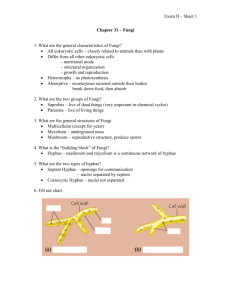

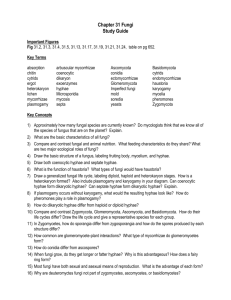
![General Mycology [33 slides]](http://s3.studylib.net/store/data/009666096_1-8b8b538a5c288d48feb634b8753cbf86-300x300.png)




